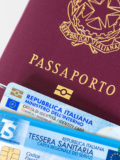Glossary Selfie Identification
Selfie Identification
What is selfie identification?
In the digital age, the ordinary selfie takes on a new meaning with the selfie ID. It is no longer just a snapshot of the moment; it can also be used to verify your online identity. So, what exactly is a selfie ID, and how is it used for digital identity verification?
What does selfie identification mean?
Selfie-Ident is a process for verifying a person's identity using a selfie, short for “selfie identity verification”. The photo is compared with stored reference data to confirm its authenticity. Unlike conventional identity verification methods, which rely on personal data, passwords or biometric features, selfie ident uses visual confirmation through a self-portrait, which can be a photo or video.
How does selfie identification work?
 Selfie identification is a system that uses biometric facial recognition and machine learning technologies. The process begins with the scanning of an identity document. Once this has been submitted, the user is asked to record a video of themselves taking a selfie, usually via a special app or platform. This video is then compared with the reference data from the scanned document to verify the user's identity.
Selfie identification is a system that uses biometric facial recognition and machine learning technologies. The process begins with the scanning of an identity document. Once this has been submitted, the user is asked to record a video of themselves taking a selfie, usually via a special app or platform. This video is then compared with the reference data from the scanned document to verify the user's identity.
Algorithms are used to analyse recorded images or videos objectively. Various facial features are recorded and compared to check they match the reference data. Attention is paid not only to the similarity of the features, but also to whether the image is genuine. This verification process ensures that the image is genuine and not fake.
One key aspect is the recognition of movement and liveliness. Some systems therefore require users to perform specific actions or, for example, to hold their ID next to their face to confirm the authenticity of the selfie.
Selfie videos are often used instead of images to check liveness, as they can capture movements and dynamic features that are typically human. When using Active Liveness Detection technology, users can be asked to blink, move or say certain words during the recording to confirm that it is live and not pre-recorded. With Passive Liveness Detection technology, such as that used in PXL Vision's solutions, the user can behave naturally in front of the camera.
Where is the selfie identification used?
Selfie identification is used in various digital contexts where fast, secure identity verification is required. For example, banks and financial service providers use this method to confirm the identity of their customers when opening an account or carrying out transactions via mobile applications.
It is also used in the telecommunications industry, particularly for activating new mobile phone contracts and for identity checks to access certain services and functions.
The travel and transport industry has also started using the procedure at airports and border crossings. This makes identity checks and the travel process faster and more reliable for everyone involved.
In general, many online platforms and services use self-identification to ensure the security of their users and offer them a quick and easy process. Gambling providers and e-commerce platforms are just two examples of companies that rely on this method to verify the identity or age of their customers and prevent fraud.
This is how identity verification via selfie identification works
Verifying your identity using a Selfie-Ident is usually a straightforward process that takes just a few steps. First, the user is asked to scan or read an identity document. They then take a selfie, either via a dedicated app or by accessing the smartphone camera via a link.
The selfie is then analysed. This analysis includes aspects such as facial structure, the distance between the eyes, and other relevant facial features. A facial recognition algorithm then compares the selfie with stored reference data. This data can be obtained from previously stored photos of the user or from biometric information stored on an NFC chip in the identity document. The aim is to establish a match between the selfie and the reference data.
What you need to know about selfie identification
When taking a selfie, there are a few important factors to consider. Lighting conditions, for example, play a decisive role as they influence the quality of the picture. Ideally, the lighting should be even, without strong shadows or overexposure. Balanced lighting ensures that facial features are clear and recognisable.
The shooting angle is also important. It is best to hold your face straight on to the camera to allow a clear view of your features. The head should not be tilted or turned too much in order to achieve the most natural angle possible.
Image quality and stability are crucial. Blurred or out-of-focus images can hinder the identity verification process. Sufficient lighting is also important.
Essentially, you should pay attention to the same things as you would when taking a good selfie. As this is now common practice, selfie identification is user-friendly and requires little effort. This is especially true if the software is as intuitive as ours, in that the user does not have to perform any unnatural actions in front of the camera to verify liveness and authenticity.
The benefits of selfie identification
Selfie identification offers numerous advantages, making it an attractive method of identity verification.
- User-friendly: It only requires a smartphone or other device with a camera to take a selfie or short video. This makes the process easily accessible for users.
- Fast: Identity verification via selfies is quick. Users can conveniently confirm their identity in real time, eliminating the need for in-person presence. This is particularly beneficial for online transactions or account opening, as it speeds up the entire process.
- Secure: Modern facial recognition and machine learning algorithms ensure the security of selfie identification. A key feature is the use of biometric data for identity verification. Characteristics such as facial features and structures are highly unique and difficult to manipulate or reproduce. Not only are static features such as the shape and structure of the face used, but dynamic features such as facial expressions and movements are also employed, increasing the accuracy of identification and making forgery more difficult.
Selfie identification is an effective method of identity verification for numerous digital use cases, offering a combination of ease of use, speed and security.
Conclusion
Selfie identification is a user-friendly and efficient way to confirm your identity in a variety of digital scenarios. It has become popular in various industries, such as finance and telecommunications, and is used as a versatile identity verification option. Its advantages lie in its user-friendliness, speed, and the security of its modern identity verification procedures.
Overall, selfie identification is a modern, efficient solution that facilitates identity verification in the digital age while maintaining high security standards. It strikes a balance between ease of use and reliability, and its importance will only grow as digital landscapes evolve and the need for secure identity verification increases.
Would you like to implement reliable, user-friendly identity verification procedures in your customer onboarding processes? Contact us – we would be happy to advise you.
FAQ on selfie identification
The duration may vary depending on the requirements of the respective platform or service. However, the process is usually quick and only takes a few minutes. With PXL Ident, identity verification takes less than 30 seconds.
A smartphone with a functioning camera is usually all that is needed for a selfie identification. Most platforms or services that use this procedure require a selfie or short selfie video to verify your identity.
.png?width=126&height=101&name=logo%20(2).png)
.png?width=63&height=51&name=logo%20(6).png)




